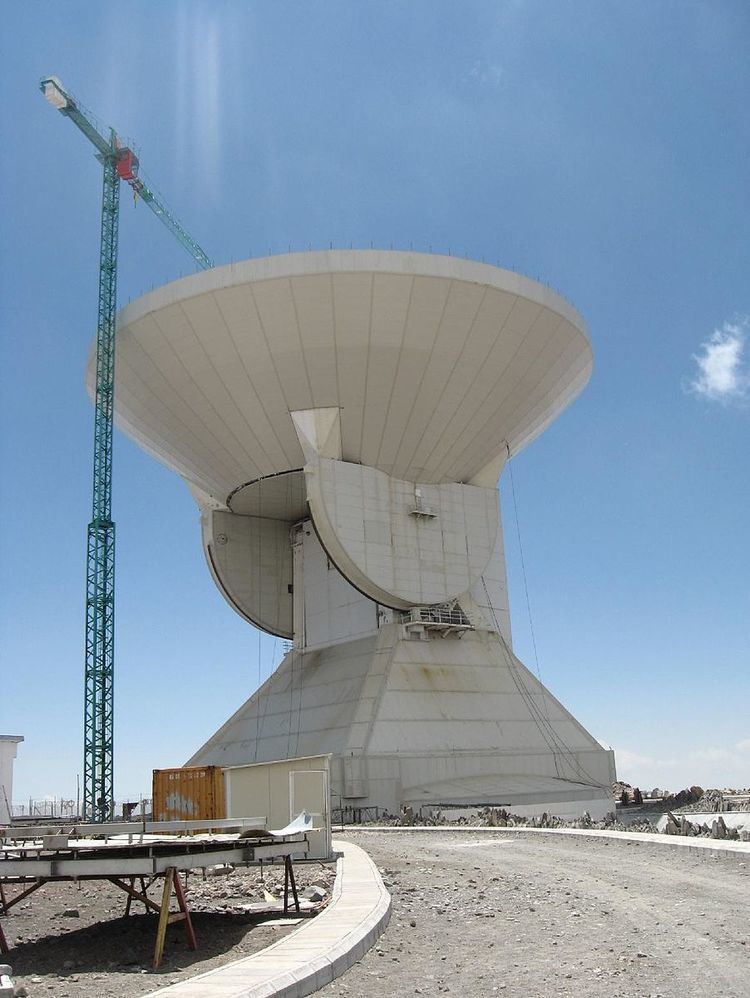Built 2001–2010 | Wavelength 0.85–4 mm (75–350 GHz) Phone +52 222 266 3100 | |
 | ||
Organisation Altitude 4,640 metres (15,200 ft) First light June 17, 2011 (2011-06-17) Hours Open today · Open 24 hoursSundayOpen 24 hoursMondayOpen 24 hoursTuesdayOpen 24 hoursWednesdayOpen 24 hoursThursdayOpen 24 hoursFridayOpen 24 hoursSaturdayOpen 24 hours Similar Sierra Negra, Pico de Orizaba, Tonantzintla Observatory, Atacama Large Millimeter, Green Bank Telescope | ||
Large millimeter telescope one
The Large Millimetre Telescope (LMT) (Spanish: Gran Telescopio Milimétrico, or GTM) was inaugurated in Mexico on 22 November 2006. It is the world's largest single-aperture telescope in its frequency range, built for observing radio waves in the wave lengths from approximately 0.85 to 4 mm. It has an active surface with a diameter of 50 metres (160 ft) and 1,960 square metres (21,100 sq ft) of collecting area.
Contents
- Large millimeter telescope one
- Large millimeter telescope four
- High costs
- Delays in finishing the project
- Building Expertise
- Thefts
- References
It is located within Chalchicomula de Sesma municipality, on top of the Sierra Negra, the fifth highest peak in Mexico and an extinct volcanic companion to Mexico's highest mountain, the Pico de Orizaba, in the state of Puebla. Its construction took 10 years, and cost 116 million dollars. It is a binational Mexican (80%) – American (20%) joint project of the Instituto Nacional de Astrofísica, Óptica y Electrónica (INAOE) and the University of Massachusetts Amherst.
Millimetre wavelength observations using the LMT will give astronomers a view of regions which are obscured by dust in the interstellar medium, thus increasing our knowledge about star formation. The telescope is also particularly fitted for observing solar system planetesimals and planets and extra-solar protoplanetary disks which are relatively cold and emit most of their radiation at millimetre wavelengths. There are also proposals for observing fluctuations in the cosmic microwave background as well as active galactic nuclei.
Large millimeter telescope four
High costs
Through 2012, the total reported investment for the GTM by Mexico had surpassed 1,548.6 million Mexican pesos (around 130 million USD). The telescope, now in its first phase of early scientific operations, has an annual cost of 5.5 million USD per year, which makes it the largest and most expensive scientific venture in Mexico's history. However, this investment is still modest when compared to other major astronomical facilities worldwide.
Delays in finishing the project
The telescope construction officially lasted six years, from early 2000 until its inauguration by president Fox in November 2006, but actually still goes on. LMT made a token first astronomical observation at 12 GHz (or 2.5 cm) in 2006 during the inauguration, but its first light in the millimetre band could not be announced until 1 June 2011. LMT started a phase of early science operations in May 2013 and has been operating as a 32 m telescope since. The current surface makes it slightly larger than the IRAM 30m telescope and therefore the largest single dish millimetre telescope in the world, though only by a little and only in the 4 mm to 1.3 mm bands. As of 2016, the scientific output of the telescope remains modest. The surface of the telescope was to be completed late in 2015 and will have to be adjusted to usefully operate down to 0.8 mm. In 2012 the project was accused of having been "inaugurated" on two occasions, but the visit of president Felipe Calderon Hinojosa in September 2012 was in fact carefully termed a "visit of supervision".
Building Expertise
The LMT project has had the goal of building expertise at INAOE, which together with UNAM (the largest Mexican university) has the most important astronomical community in Mexico. In 1992 INAOE did not have a solid dedicated group of national nor foreign radio astronomers and has been working in its development since. The involvement from the scientists at INAOE represented over 50% of the proposals received in the August 2014 call for proposals.
The building expertise on the Mexican side is reflected on the Project Scientist on the Mexican side, Chavez-Dagostino, which has been increasing his publications on radio and millimetre astronomy.
Thefts
In 2012, 128 real panels were stolen from the GTM installations before they were installed. They were recovered by Mexican authorities from the house of one of the thieves after an anonymous tip.
